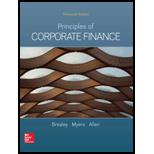
Principles of Corporate Finance
13th Edition
ISBN: 9781260465099
Author: BREALEY, Richard
Publisher: MCGRAW-HILL HIGHER EDUCATION
expand_more
expand_more
format_list_bulleted
Concept explainers
Textbook Question
Chapter 29, Problem 26PS
- a. No external debt or equity is to be issued?
- b. The firm maintains a fixed debt ratio but issues no equity?
Expert Solution & Answer
Want to see the full answer?
Check out a sample textbook solution
Students have asked these similar questions
I need assistance with financial accounting question
I need help finding the accurate solution and financial accounting question
I am looking for help with this financial accounting question
Chapter 29 Solutions
Principles of Corporate Finance
Ch. 29 - Sources and uses of cash State whether each of the...Ch. 29 - Sources and uses of cash Table 29. 11 shows...Ch. 29 - Prob. 3PSCh. 29 - Sources and uses of cash and working capital...Ch. 29 - Prob. 5PSCh. 29 - Prob. 6PSCh. 29 - Cash cycle A firm is considering several policy...Ch. 29 - Collections on receivables Here is a forecast of...Ch. 29 - Collections on receivables If a firm pays its...Ch. 29 - Forecasts of payables Dynamic Futon forecasts the...
Ch. 29 - Cash budget Table 29.13 lists data from the budget...Ch. 29 - Short-term financial plans a. Paymore places...Ch. 29 - Short-term financial plans Which items in Table...Ch. 29 - Short-term financial plans Work out a short-term...Ch. 29 - Prob. 16PSCh. 29 - Prob. 17PSCh. 29 - Long-term financial plans Corporate financial...Ch. 29 - Prob. 19PSCh. 29 - Prob. 20PSCh. 29 - Long-term financial plans Construct a new model...Ch. 29 - Long-term financial plans a. Use the Dynamic...Ch. 29 - Long-term financial plans Table 29.15 summarizes...Ch. 29 - Long-term financial plans Abbreviated financial...Ch. 29 - Prob. 25PSCh. 29 - Forecast growth rate What is the maximum possible...Ch. 29 - Forecast growth rate a. What is the internal...Ch. 29 - Forecast growth rate Bio-Plasma Corp. is growing...Ch. 29 - Long-term plans Table 29.18 shows the 2019...
Knowledge Booster
Learn more about
Need a deep-dive on the concept behind this application? Look no further. Learn more about this topic, finance and related others by exploring similar questions and additional content below.Similar questions
- Darla owes the government $1,800 in taxes this year. She earns a tax credit for childcare for $1, 500, $678 for earned income tax, and $250 for an energy-efficient home. How much will Darla owe the government for taxes this year?arrow_forwardI need help with financial accounting questionarrow_forwardGiven the solution and financial accounting questionarrow_forward
arrow_back_ios
SEE MORE QUESTIONS
arrow_forward_ios
Recommended textbooks for you
 Financial Reporting, Financial Statement Analysis...FinanceISBN:9781285190907Author:James M. Wahlen, Stephen P. Baginski, Mark BradshawPublisher:Cengage Learning
Financial Reporting, Financial Statement Analysis...FinanceISBN:9781285190907Author:James M. Wahlen, Stephen P. Baginski, Mark BradshawPublisher:Cengage Learning Intermediate Financial Management (MindTap Course...FinanceISBN:9781337395083Author:Eugene F. Brigham, Phillip R. DavesPublisher:Cengage Learning
Intermediate Financial Management (MindTap Course...FinanceISBN:9781337395083Author:Eugene F. Brigham, Phillip R. DavesPublisher:Cengage Learning EBK CONTEMPORARY FINANCIAL MANAGEMENTFinanceISBN:9781337514835Author:MOYERPublisher:CENGAGE LEARNING - CONSIGNMENT
EBK CONTEMPORARY FINANCIAL MANAGEMENTFinanceISBN:9781337514835Author:MOYERPublisher:CENGAGE LEARNING - CONSIGNMENT

Financial Reporting, Financial Statement Analysis...
Finance
ISBN:9781285190907
Author:James M. Wahlen, Stephen P. Baginski, Mark Bradshaw
Publisher:Cengage Learning

Intermediate Financial Management (MindTap Course...
Finance
ISBN:9781337395083
Author:Eugene F. Brigham, Phillip R. Daves
Publisher:Cengage Learning

EBK CONTEMPORARY FINANCIAL MANAGEMENT
Finance
ISBN:9781337514835
Author:MOYER
Publisher:CENGAGE LEARNING - CONSIGNMENT

Dividend disocunt model (DDM); Author: Edspira;https://www.youtube.com/watch?v=TlH3_iOHX3s;License: Standard YouTube License, CC-BY